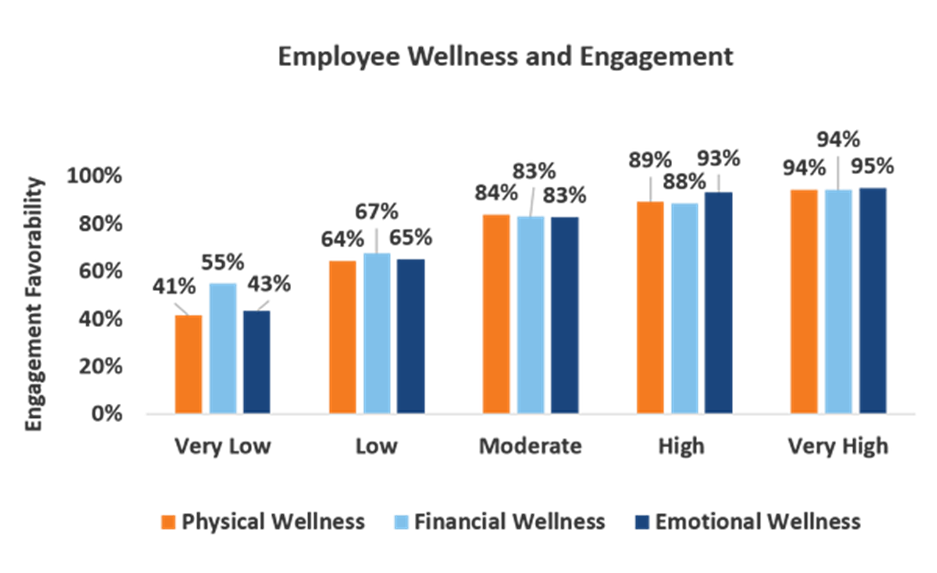Establishing a strong employee wellness program is critical for employers, yet with more workplaces featuring multi-generational workers, reaching balance remains a challenge
Before 2020, managing employee wellness was already seen as a challenge and one that could impact employee engagement. Indeed, it seems that engagement and wellness are ineradicably linked, according to one recent study, which suggested that “employee engagement positively relates to wellness because engagement is noticeably lower among employees experiencing low or very low physical, financial or emotional wellness.”

Further, the impact of wellness and engagement in differing generational cohorts has been under-recognized. It is no secret that Gen Zers and young Millennials, who as a group became very vocal about their stress, depression, and mental health concerns in the years leading up to the onset of the global pandemic, drove the increased demand for attention to well-being at work. The pandemic and all the additional stressors occurring simultaneously, however, only increased the necessity for employers to help their employees cope and remain productive.
These trends also expanded the definition of employee wellness to include financial, emotional, and psychological concerns in addition to physical factors. For example, many employers expanded their benefit offerings to include student loan pay-off programs, subsidized childcare, pet insurance, unpaid leave policies and even fertility and pregnancy support.
Differing elements of wellness across generations
Job insecurity and financial pressures spiked during the pandemic and put employee well-being at the center of employer concerns, exacerbated by the experience of toxic or stressful work cultures. The following elements were especially challenging for employees and their employers.
Career development — Hybrid work has complicated career development and progression for Gen Z employees in the legal and tax & accounting fields because, prior the pandemic, much of training and on-boarding had traditionally happened in an apprenticeship model at the office. This traditional model had greatly benefitted those professionals in the older Millennials, Gen X, and Baby Boomers cohort. Now, employers are figuring out new ways to address this very necessary part of a younger workers’ career; in fact, career development and progression are of top concern for employee retention in the current hot talent market.
Career development remains the most important retention factor. In a survey of American workers released in October 2021, only 38% of employees who had left their jobs said they saw professional growth and career development opportunities for themselves at their organizations, which may mean that almost two-thirds of employees did not see such growth opportunities.
Building connections — Human relationships, especially those that impact employee wellness, are another factor with some generational differences. Before the pandemic, Millennial, Gen Xers, and Boomers had the benefit to develop relationships with peers and work colleagues because of the in-person work environment. Now, Gen Zers have a harder time developing relationships with colleagues and mentors given hybrid and remote working patterns. This change has increased the danger of generational segregation and hinders the most effective collaboration and teamwork.
Caregiving — Another generational complexity is the tremendous pressure on working caregivers. This includes working parents, especially mothers with young children, and those with the responsibility of caring for elderly family members. These roles are most prevalent among Gen X and older Millennials.
Childcare offerings have always been localized, growing in cost, and somewhat fragmented. However, the pandemic worsened the situation in terms of making options less affordable and less available, especially for those parents with children under five years old and home-schoolers before vaccinating young children became more widespread.
Well-being of working caregivers, many of whom are in Gen X and the Boomer generations, has suffered. During the pandemic, many people could not visit their parents in nursing homes and assisted living places or elderly family members who required hospitalization during the pandemic.
Wellness factors that are universal across all generations
Ubiquitous across all generations are those critical wellness factors related to diversity, equity & inclusion (DEI) as well as to employees finding individual purpose and fulfillment in their work. Strong feelings of belonging and a positive sense of fulfillment at work improve both employee engagement, well-being and the bottom line, studies show. For example:
-
-
- High feelings of belonging were linked to a whopping 56% increase in job performance, a 50% drop in turnover risk, and a 75% reduction in sick days. For a 10,000-person company, this would result in annual savings of more than $52 million.
- Other research concluded that organizational commitment “had a more persistent influence on performance at the business unit level than vice versa,” leading the researchers to conclude that job attitudes lead to improvements in business unit performance.
-
Small actions make a big difference
To maximize employee wellness in this newly emerging, often hybrid or remote work environment, there are several actions that employers and managers can implement across all generations, including:
-
-
- Consistently check in on each individual employee’s emotional and mental wellbeing. It’s imperative for employers to integrate connection and engagement seamlessly into everyday behaviors and activities, rather than treating it as a separate task.
- Invite employees from all generations to contribute ideas to wellness policies. By listening to colleagues across generations, the organization can benefit from new creative solutions.
- Encourage managers to demonstrate vulnerability. This practice can create or enhance psychological safety, (defined as trust and cohesion at the group or team level and the belief that you can show up to work and within your team as yourself.) Managers sharing their own feelings and mental health struggles gives permission and encouragement for others to do so.
-
These actions as part of an ongoing program of employee wellness will help increase employee retention, alleviate long-term employee burn-out, and have positive impact on organizational bottom lines.







